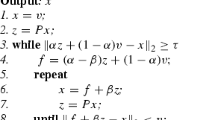Abstract
We consider the problem of computing PageRank. The matrix involved is large and cannot be factored, and hence techniques based on matrix-vector products must be applied. A variant of the restarted refined Arnoldi method is proposed, which does not involve Ritz value computations. Numerical examples illustrate the performance and convergence behavior of the algorithm.
Similar content being viewed by others
References
W. E. Arnoldi, The principle of minimized iteration in the solution of the matrix eigenvalue problem, Quart. Appl. Math., 9 (1951), pp. 17–29.
A. Berman and R. J. Plemmons, Nonnegative Matrices in the Mathematical Sciences, SIAM, Philadelphia, PA, 1994.
M. Bianchini, M. Gori, and F. Scarselli, Inside PageRank, ACM Trans. Internet Technol., 5 (2005), pp. 92–128.
P. Boldi, M. Santini, and S. Vigna, PageRank as a function of the damping factor, in Proceedings of the Forteenth International World Wide Web Conference, Chiba, Japan, pp. 557–566, ACM Press, New York, 2005.
J. W. Demmel, Applied Numerical Linear Algebra, SIAM, Philadelphia, PA, 1997.
L. Eldén, A note on the eigenvalues of the Google matrix, Report LiTH-MAT-R-04-01, Linköping University, 2003.
R. E. Funderlic and C. D. Meyer, Sensitivity of the stationary distribution vector for an ergodic Markov chain, Linear Algebra Appl., 76 (1986), pp. 1–17.
D. Gleich, L. Zhukov, and P. Berkhin, Fast parallel PageRank: a linear system approach, Yahoo! Research Technical Report YRL-2004-038, available via http://research.yahoo.com/publication/YRL-2004-038.pdf, 2004.
G. H. Golub and C. F. Van Loan, Matrix Computations, 3rd edn., Johns Hopkins University Press, Baltimore, MD, 1996.
G. H. Golub and C. D. Meyer, Using the QR factorization and group inverse to compute, differentiate, and estimate the sensitivity of stationary probabilities for Markov chains, SIAM J. Algebra Discr., 17 (1986), pp. 273–281.
T. H. Haveliwala and S. D. Kamvar, The second eigenvalue of the Google matrix, Technical report 2003-20, Stanford University, available via http://dbpubs.stanford.edu:8090/pub/2003-20, 2003.
R. Horn and S. Serra-Capizzano, Canonical forms for certain rank one perturbations and an application to the Google PageRanking problem, Internet Math., to appear.
I. C. F. Ipsen and S. Kirkland, Convergence analysis of an updating algorithm by Langville and Meyer, SIAM J. Matrix Anal. Appl., 27 (2006), pp. 952–967.
I. C. F. Ipsen and R. S. Wills, Mathematical properties and analysis of google’s PageRank, Bol. Soc. Esp. Mat. Apl., 34 (2006) pp. 191–196.
Z. Jia, Refined iterative algorithms based on Arnoldi’s process for large unsymmetric eigenproblems, Linear Algebra Appl., 259 (1997), pp. 1–23.
Z. Jia and G. W. Stewart, An analysis of the Rayleigh–Ritz method for approximating eigenspaces, Math. Comp., 70 (2001), pp. 637–647.
S. D. Kamvar and T. H. Haveliwala, The condition number of the PageRank problem, Technical report 2003-36, Stanford University, available via http://dbpubs.stanford.edu:8090/pub/2003-36, 2003.
S. D. Kamvar, T. H. Haveliwala, and G. H. Golub, Adaptive methods for the computation of PageRank, Linear Algebra Appl., 386 (2004), pp. 51–65.
S. D. Kamvar, T. H. Haveliwala, C. D. Manning, and G. H. Golub, Extrapolation methods for accelerating PageRank computations, in Proceedings of the 12th International Conference on World Wide Web, Budapest, Hungary, 2003, available also as Stanford Technical Report SCCM-02-15, ACM Press, New York, 2003.
A. N. Langville and C. D. Meyer, Deeper inside PageRank, Internet Math., 1 (2005), pp. 335–380.
A. N. Langville and C. D. Meyer, A survey of eigenvector methods for Web information retrieval, SIAM Rev., 47 (2005), pp. 135–161.
C. D. Meyer, The character of a finite Markov chain, in Linear Algebra, Markov Chains, and Queueing Models, IMA Vol. Math. Appl., C. D. Meyer and R. J. Plemmons, eds., pp. 47–58, vol. 48, Springer, Berlin, 1993.
C. D. Meyer and G. W. Stewart, Derivatives and perturbations of eigenvectors, SIAM J. Numer. Anal., 25 (1988), pp. 679–691.
A. Y. Ng, A. X. Zheng, and M. I. Jordan, Link analysis, eigenvectors and stability, in Seventeenth International Joint Conference on Artificial Intelligence, pp. 903–910, Morgan Kaufmann, Seattle, WA, 2001.
L. Page, S. Brin, R. Motwani, and T. Winograd, The PageRank citation ranking: bringing order to the web, Technical report 1999-66, Stanford University, Stanford Digital Libraries, available via http://dbpubs.stanford.edu:8090/pub/1999-66, 1999.
Y. Saad, Iterative Methods for Sparse Linear Systems, 2nd edn., SIAM, Philadelphia, PA, 2003.
S. Serra-Capizzano, Jordan canonical form of the Google matrix: a potential contribution to the PageRank computation, SIAM J. Matrix Anal. Appl., 27 (2005), pp. 305–312.
W. J. Stewart, Introduction to the Numerical Solution of Markov Chains, Princeton University Press, Princeton, NJ, 1994.
J. H. Wilkinson, The Algebraic Eigenvalue Problem, Clarendon Press, Oxford, 1965.
D. Zhou, J. Huang, and B. Schölkopf, Learning from labeled and unlabeled data on a directed graph, in Proceedings of the 22nd International Conference on Machine Learning, Bonn, 2005, ACM Press, New York, 2005.
Author information
Authors and Affiliations
Corresponding author
Additional information
AMS subject classification (2000)
65F15, 65C40
Rights and permissions
About this article
Cite this article
Golub, G., Greif, C. An Arnoldi-type algorithm for computing page rank . Bit Numer Math 46, 759–771 (2006). https://doi.org/10.1007/s10543-006-0091-y
Received:
Accepted:
Published:
Issue Date:
DOI: https://doi.org/10.1007/s10543-006-0091-y




